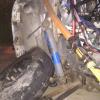Hey Y'all
My temperature gauge smoked out so I removed it from the car. Now I've finally got round to taking it apart and it looks pretty simple. But there's a couple of bits that either don't look right to me, or at least I'm struggling to comprehend how it works or if because its broken it looks like it does now
Please note, its not a named brand gauge, all that it is is on the back of the case "Japan", "12V", "I", "U" and "E".
In the 4 attached photos:
Looking at "main.jpg" there's a piece on the left that looks a bit orange and horrible, but nothing I would usually worry about in a gauge of this age
But on the right there's the wire wrapped around the piece of metal in a really rough way, and the piece coming out of the bundle looks to me where it probably burnt out because the white covering has gone and it looks like raw copper or something.
Looking at "touching.jpg" again there's the lever at the top right square that moves away from the piece its touching, whether it should be or not I don't know?
Looking at "focused.jpg" I'm pulling the lever away with the screwdriver so yee can grasp what I mean :)
The whole insides are impressively fragile, but I wasn't too sure what to expect so!
The needle attaches at the bottom in some fashion I can't quite work out but that's not my main issue
If anyone can help with what looks wrong / right /broken or anything, it would be much appreciated ![]()
I'm holding no hopes of getting it working again, but would be nice to know what happened or perhaps try and fix it :)
Thanks very much in advance ![]()


















